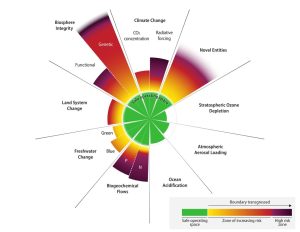INSIGHT by Potsdam Institute for Climate Impact Research (PIK)
For the first time, an international team of scientists is able to provide a detailed outline of planetary resilience by mapping out all nine boundary processes that define a safe operating space for humanity. From global warming to the biosphere and deforestation, from pollutants & plastic to nitrogen cycles and freshwater: Six of nine planetary boundaries are being transgressed, while pressure in all those boundary processes is increasing, cutting-edge research published in the journal Science Advances shows.

Six of nine planetary boundaries are currently transgressed. The length of the wedges symbolizes what the current state of the corresponding process is, in relation to the distance from the planetary boundary (end of the green area) and the Holocene baseline (origin of the diagram). The color symbolizes the risks associated with each. For example, a wedge may be very long because the current state is already very far from the planetary boundary and the Holocene. But it may still not be purple, because that is not yet associated with very high risks in this particular case. In other cases already a “small” overshoot (short wedge) results in a big risk: Then the color further inside already changes to purple.
“This update on planetary boundaries clearly depicts a patient that is unwell, as pressure on the planet increases and vital boundaries are being transgressed. We don’t know how long we can keep breaching these key boundaries before combined pressures lead to irreversible change and harm”, says co-author Johan Rockström, Director of the Potsdam Institute for Climate Impact Research (PIK).
The second major planetary boundaries update, since the framework was introduced in 2009, is the first to provide a complete check-up of all nine processes and systems that determine the stability and resilience of the planet. While a boundary transgression is not equivalent to drastic changes happening overnight, they mark a critical threshold for increasing risk. Lead-author Katherine Richardson from the University of Copenhagen explains further: “We can think of Earth as a human body, and the planetary boundaries as blood pressure. Over 120/80 does not indicate a certain heart attack but it does raise the risk and, therefore, we work to reduce blood pressure. The boundary for ozone depletion, for example, while not transgressed globally, was headed for increasing regional transgressions. Though it still is exceeded today over Antarctica, it is now slowly recovering – thanks to global initiatives, catalyzed by the Montreal Protocol.”
| Beyond climate: What’s new in the second Planetary Boundaries Update?
For the first time, the novel entities boundary has been quantified, and the assessment shows that it is transgressed. It includes the accumulation of all novel chemical compounds created by humans, such as micro-plastics, pesticides and nuclear waste. Also, in a first, there is now scientific evidence to quantify the boundary of atmospheric aerosol loading – this boundary is not transgressed yet, even though regional transgressions do occur, e.g., in South Asia. The freshwater boundary now addresses both green water (held in soil and plants in farms, forests etc.) and blue water (rivers, lakes etc) – both boundaries are transgressed. As another first, a control variable for the biosphere integrity was introduced – revealing evidence for another crossed boundary which in fact has been crossed since the late 19th century, when global agriculture and forestry saw major expansions. Planetary resilience goes well beyond climate change, the researchers underline.
“Next to climate change, integrity of the biosphere is the second pillar of stability for our planet. And as with climate, we are currently destabilising this pillar by taking out too much biomass, destroying too much habitat, deforesting too much land etc. Our research shows that mitigating global warming and saving a functional biosphere for the future should go hand in hand”, co-author Wolfgang Lucht, head of PIK’s department of Earth System Analysis, stresses.
| Guidance to address the Earth System as a whole
Deploying intricate computer models and simulations at PIK has played a major part in the study. The Potsdam Earth System Model (POEM) for instance, was used to study interactions between climate and biosphere. Simulations were computed forward with POEM and its biosphere model LPJmL for several hundred years to include not just processes that react relatively quickly to change, but also the much slower Earth system processes that ultimately determine the outcome of environmental change caused today.
“Science and the world at large are really concerned about the rising signs of dwindling planetary resilience, manifested by the transgression of planetary boundaries, which brings us closer to tipping points, and closes the window to have any chance of holding the 1.5°C planetary climate boundary”, PIK Director Johan Rockström concludes. “At the same time, it is a true breakthrough that we now have a scientifically quantified safe space for humanity on Earth, providing a guide for action and the first full picture of our planet’s capacity to buffer stress. Having this knowledge at hand marks an important step for more systematic efforts to protect, recover and rebuild planetary resilience.”
| All opinions expressed are those of the author and/or quoted sources. investESG.eu is an independent and neutral platform dedicated to generating debate around ESG investing topics.









